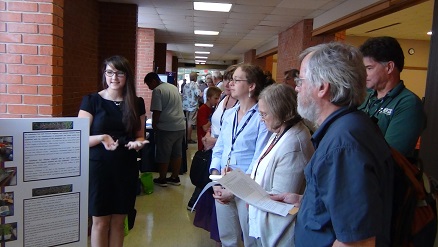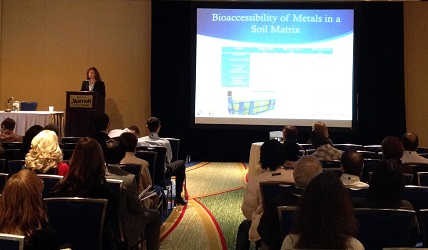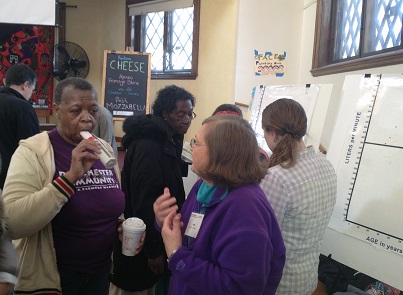Superfund Research Program
Research Translation Core
Project Leader: Joel Schwartz
Co-Investigator: Katherine E. von Stackelberg
Grant Number: P42ES016454
Funding Period: 2010-2015
![]()
Project-Specific Links
- Project Summary
Final Progress Reports
Year: 2013

Figure 1: The RTC organized and served as judges for the 15th National Tar Creek Conference Science Fair. (Photo courtesy of Harvard)
Participation at National Conferences: Members of the RTC participated in numerous national conferences throughout the year. Dr. Katherine von Stackelberg, Core Leader, presented on various aspects of the Harvard Superfund Program to diverse audiences at Environmental Health 2013 , the Annual International Conference on Soils, Sediments, Water, and Energy sponsored by the Association for Environmental Health and Sciences Foundation, the American Public Health Association (APHA) Annual Meeting, and the Society for Risk Analysis Annual Meeting. RTC member, Ann Backus presented two sessions at the APHA Conference and gave a talk about assessment and communication in complex exposure environments at the EPA Community Training Conference. Liz Guzy represented the RTC at the Partnerships for Environmental Public Health Environmental Justice Conference this summer with a poster on using art as advocacy in environmental justice communities.
Methods for Research Synthesis: The RTC, together with the National Science Foundation and others, sponsored an international workshop on cross-disciplinary research synthesis methods to support policy development. The workshop was held at Harvard University and featured two days of presentations and discussions. A special issue of Risk Analysis is planned and submitted papers are currently in review. Dr. Katherine von Stackelberg gave a presentation on a proposed adverse outcome pathway based on a systematic review of prenatal and perinatal exposures to mixtures of metals and neurodevelopmental health outcomes in children. The purpose of the review was to synthesize, integrate, and evaluate the evidence for the potential for synergistic effects associated with exposure to mixtures of metals.

Figure 2: Dr. von Stackelberg presents at Environmental Health 2013. (Photo courtesy of Harvard)
Website and Social Media: Since launching a new website in early 2013, the RTC has measured an increase in web visitors, especially in those coming to the site for the first time. The percentage of new visitors ranges from 72 to 87 , demonstrating the RTC's ability to reach new audiences. Time spent on the site averages between three to seven minutes. Page views have stayed relatively consistent along with a low 3 bounce rate. Many site visitors are from outside the United States and Canada, including Pakistan, Bangladesh and India. In addition to the home page, the most popular pages include the events page and the various newsletter articles. One of the most popular posts was about the investigation of high lead levels in a rural region of Bangladesh that led to detecting lead in turmeric powder. The quarterly newsletter maintains an effective form of research translation. The RTC newsletter currently has over 180 subscribers and receives new subscribers frequently. Of those that open the newsletter, around 60 click through to the articles and less than 0.5 choose to unsubscribe. The most popular newsletter was from this past summer, where RTC researchers announced their social media presence and featured articles about: using the Harvard World Map database to create collaborative health maps, trainee Peter Wagner's passion for mentoring, and how a photography professor uses his camera for environmental advocacy.
Since joining Twitter in 2012, the account followers have increased 300 and the researchers have seen around 15 of their website visitors find them through Twitter. The researchers focus on engaging with their followers on a daily basis by sharing their research, relevant articles, and promoting events. They are excited about NIEHS's focus on social media for the SRP community and have enjoyed collaborating with other SRPs using these platforms. RTC researchers have seen a dramatic increase in other followers retweeting, mentioning, and favoriting their content, helping them reach broader audiences.
Exposure Study of Lead in Bangladesh: Following the discovery of significantly elevated blood lead levels in children at one particular clinic through the Epidemiology of Developmental Windows, Metal Mixtures and Neurodevelopment project together with a request from the Dhaka Community Hospital, the RTC and the Epidemiology of Developmental Windows, Metal Mixtures and Neurodevelopment and Geochemical Processes Affecting Temporal Variability in Soil Metal Bioaccessibility projects developed a sampling program to help identify potential exposure sources. The project, featured in the newsletter, identified spices, particularly turmeric, as well as paternal occupational exposures as possible sources. Dr. Maitreyi Mazumdar of the Epidemiology of Developmental Windows, Metal Mixtures and Neurodevelopment project was subsequently asked to participate in a press release and responded to questions from the community. Dr. Katherine von Stackelberg, Leader of the RTC, continues her active participation on panels and in professional societies. She is currently the elected Treasurer for the Society for Risk Analysis, and Chairs the US EPA's Office of Research and Development Board of Scientific Counselors (BOSC). In that capacity, she serves as liaison to the Science Advisory Board and participated in numerous meetings throughout the year. She serves as Chair of the Society for Environmental Toxicology and Chemistry's (SETAC) Global Science Committee. SETAC enjoys a large and diverse membership, and the SC is responsible for reviewing workshop proposals, technical issue papers, and identifying emerging environmental issues of broader concern. Dr. von Stackelberg was asked to serve as peer reviewer for the US EPA Pathfinder Innovation Projects. She serves on three committees of the Interstate Technology & Regulatory Council (ITRC), including risk assessment, contaminated sediments, and remediation of complex sites. The ITRC develops information resources and technically sound innovative solutions and technologies particularly in the context of hazardous waste site management.
Kids+Chemical Safety Collaboration: The RTC developed a collaboration with the Kids+Chemical Safety website by providing peer review, editing, and content contributions, particularly for the "ask an expert" link. This year, the Harvard SRP RTC and researchers responded to reader-submitted questions ranging from effects of exposure to flame-retardant pajamas to levels of aluminum in infant formula. The Kids+Chemical Safety website is a top resource for concerned parents when they search for related information on the web and this collaboration allows the SRP to weigh in on content presented to the general public. The ability to reach audiences that the researchers might not otherwise be able to is another great co-benefit from this collaboration.

Figure 3: Ann Backus helps a community member test her peak airflow. (Photo courtesy of Harvard)
Community Outreach and Education: At this year's Tar Creek Conference, the RTC organized and served as judges for the annual science and art fair for local school children. This year's science fair was the most successful yet, with an increase in participants and attendees! Project topics ranged from environmental impacts from air and water pollution to an experiment on bioremediation efforts using native grasses.
SRP Outreach Coordinator Ann Backus and Liz Guzy of the RTC participated in many local community health events where they helped screen volunteers with peak expiratory flow measurements and spread awareness about air pollution and respiratory health. They conducted these demonstrations at the 2013 Health of Dorchester community forum, the Cambridge Science Fair, and the Dorchester Winter Farmer's Market.
Dr. Molly Kile visited Bangladesh, where she presented research findings in a Grand Rounds at Dhaka Community Hospital Medical School, titled "Community-University Partnership: Arsenic exposure and health effects in Bangladesh"
Dr. David Bellinger gave a seminar to the Brown SRP, entitled, "Assessing the public health importance of children's exposures to environmental chemicals: An alternative approach to risk assessment."


